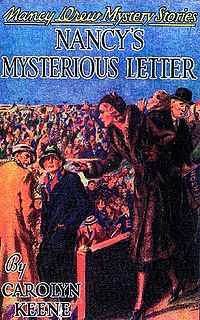Nancy's Mysterious Letter
| Nancy's Mysterious Letter | |
|---|---|
 Original edition cover | |
| Author | Carolyn Keene |
| Illustrator | Russell H. Tandy |
| Country | United States |
| Language | English |
| Series | Nancy Drew Mystery Stories |
| Genre | Juvenile literature |
| Publisher | Grosset & Dunlap |
Publication date | 1932, 1968 |
| Media type | Print (hardback & paperback) |
| ISBN | 0-448-09508-4 |
| OCLC | 35978951 |
| Preceded by | The Clue in the Diary |
| Followed by | The Sign of the Twisted Candles |
Nancy's Mysterious Letter is the eighth volume in the Nancy Drew Mystery Stories series. It was first published in 1932, and was penned by Walter Karig, a replacement writer for Mildred Wirt Benson. Benson declined series work when the Depression forced a reduction in the contract fee provided to Stratemeyer Syndicate writers, so Karig was hired.
1932 edition plot summary
After returning from Red Gate Farm on a day trip, Nancy and her friendss enjoy hot cocoa and a snack at teatime during the late fall. Postman Ira Dixon, set to retire soon, is invited inside, and leaves his mailbag in the vestibule; it is quickly stolen. Nancy immediately is summoned to Postal Authorities where she is accused of having a hand in the theft, and Dixon's pension and career are threatened. In the meantime, she is invited to spend a weekend at a big football game as a guest of Ned Nickerson's, and spends time preparing for the trip. Nancy encounters low-brow Mrs. "Sailor" Joe Skeets, who accuses her of wrongdoing due to her own missing letter containing money, stolen with the mailbag. Strangely, the letters are re-posted later. Nancy receives a letter from British solicitors informing her of a Nancy Smith Drew, sought as the heiress of an estate there. She looks for her namesake; it is revealed she has no middle name or initial. In the meantime, she seeks the primary suspect, the half brother of her mail carrier, a flashy man with a yellow coat.
Mrs. Skeets provides a clue, as does George Fayne, and Nancy discovers her counterpart is visiting faculty at Emerson. Ned is great in the big game, and Nancy sees the suspect at the game in the stadium. Nancy tries to make contact with Nancy S. Drew, and while she investigates during an unexpected layover, she and Mr. Nickerson discover a lonely hearts mail racket, with money being sent for introduction services.
Nancy saves the day for Miss Drew, and helps her avoid marriage to a crook, the dodgy Edgar Dixon, while exonerating Ira Dixon.
1968 edition plot summary
The revised edition is largely condensed, but is the same story. Ira Dixon becomes "Nixon", and the action speeds up. Nancy still goes to Emerson, but her companion in the original version, who was Helen Corning, is changed to a new acquaintance. Sub-plots involving early snowfall adding days to the Emerson trip, and Nancy's success at a hotel costume event, are eliminated. The action at Emerson now includes someone attempting to harm Nancy by releasing a heavy curtain after luring her to a deserted theater stage. Nancy is also waylaid at the airport after determining to go there to find her namesake. The details involving the football game are modernized and abridged, to reduce this story element.
Artwork
The original 1932 artwork is by the fashion illustrator Russell H. Tandy, illustrator for the Nancy Drew series from 1930 to 1949. Nancy is depicted chasing Edgar at the football stadium, with a glossy frontispiece of Nancy at the postal inspector and three glossy internal illustrations included in the original imprint. The frontispiece alone was used beginning in 1937, but the third plate, of Nancy, Nancy S. Drew, and Edgar is used. Tandy updated this illustration to pen and ink on plain paper with 1940s hairstyles in 1943. In 1950, Bill Gillies introduced cover art featuring a close-up of Nancy and Mr. Nickerson examining a letter in an Emerson residential area. This art was retained on all covers, including direct printed picture cover stock, until the 1968 text was introduced. The revised cover art by Rudy Nappi shows Nancy in a pink suit with the letter in her hand and an overlay image of the letter on a blue background. An uncredited illustrator provided a frontispiece and five plain paper internal drawings featuring rare glimpses of the interior of the Drew home. The 1968 artwork remains unchanged in current imprints.